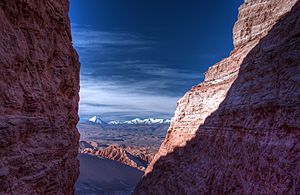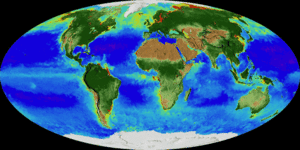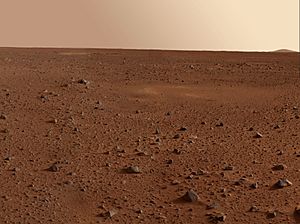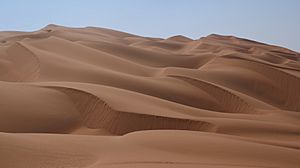Desert facts for kids

A desert is a very dry area of land. These places get less than 25 cm (9.8 inches) of rainfall each year. Another way to think about it is that deserts lose more water through evaporation than they get from rain.
Deserts cover about one-third (33%) of the Earth's land. This includes large parts of Antarctica, where it's so dry that some areas get no snow at all. The biggest hot desert is the Sahara in northern Africa, which is huge, covering 9 million square kilometers.
Desert surfaces can be different, like rocky areas, sand dunes, or even snow. Deserts are home to many different animals and plants. Sometimes, deserts grow bigger (desertification), and sometimes they shrink.
You can find most deserts in the western parts of the Americas, Western Asia, Central Australia, and South and North Africa. Many, like the Sahara, are very hot during the day and cold at night. But there are also cold deserts, such as the Atacama in South America, which stays frozen day and night.
Contents
What are the different types of deserts?
There are two main types of deserts: hot deserts and cold deserts.
Cold deserts: The icy dry lands
Cold deserts can be covered with snow or ice. Some are so dry that the ice turns directly into gas (sublimates) without melting. Some cold deserts have a short time when temperatures are above freezing. These are called tundra. An ice cap is a cold desert that stays below freezing all year.
Cold deserts are often found near the poles. That's why they are also called polar deserts. Other cold deserts are in high altitude areas, like the Himalayas. These are called montane deserts. Antarctica is the world's largest cold desert.
Hot deserts: The scorching dry lands
Hot deserts are mostly found in the subtropics. Their surfaces can be sand, rock, salt lakes, stony hills, or even mountains. Most non-polar deserts are hot during the day and cool at night. Summer daytime temperatures can reach 50 °C (122 °F) or higher. In winter, nights can drop to 0 °C (32 °F) or even colder.
The largest hot desert in the world is the Sahara in North Africa. It's almost as big as Europe or the United States! The Sahara is also the hottest desert in the world.
The driest desert in the world is the Atacama Desert in South America. The Atacama Desert had no rain for 401 years, from 1570 to 1971. A cold ocean current causes this desert to be so dry.
Polar deserts: Deserts of ice and snow
Polar deserts are a kind of cold desert. Even though they have lots of snow and ice, they are still considered deserts. This is because they get very little precipitation and have low evaporation rates.
The McMurdo dry valleys in Antarctica are a good example. They are very dry, just like hot deserts, with almost no rain, ice, or snow. They even have salty lakes and streams that freeze on the surface. Strong winds make these areas extremely dry and almost lifeless.
Biological deserts: Areas without much life

The idea of a "biological desert" means a place that lacks life, even if it has water. These can be "ocean deserts," found in the middle of ocean currents. They can also be areas with very low oxygen, called hypoxic or anoxic waters, like dead zones.
How does it rain in the desert?
It does rain in the desert, but not very often. One spot in the Atacama Desert didn't get rain for 401 years! In other deserts, it might rain every year or only once every few years. When it does rain, a lot of water can fall in a short time.
Some rain soaks into the dry soil. The rest can form a temporary river. Wadis are stream channels that are usually dry. They can quickly fill up after heavy rain, causing a flash flood.
Sometimes, people bring water from wet places to hot deserts to help plants grow. This is called irrigation.
What is a sandstorm?
A sandstorm or dust storm happens when strong winds blow loose sand and dust from a dry surface. The clouds of sand or dust can be so thick that they block out the sun. A sandstorm can even move entire sand dunes. Sandstorms are common in large, dusty deserts.
What animals and plants live in deserts?
There aren't many animals in the desert, but some are very good at surviving the tough conditions. For example, lizards, small rodents, snakes, and camels live in hot deserts. Plants and animals in hot deserts must live with very little water.
Xerophytic plants, which are desert plants, have special ways to survive. Their roots might grow very close to the surface to quickly soak up any rain before it evaporates. Plants like the cactus have thick, fleshy stems that help them store water.
Small animals like lizards and small rodents often dig underground burrows to escape the hot sun. They only come out at night to find food. Like the plants, desert animals must live on as little water as possible. Most of their water comes from the seeds and stems they eat. Camels survive in hot deserts by storing water in the fat in their humps. Like other desert animals, camels lose very little water through their waste.
What are the major deserts of the world?
Deserts make up about one-third of Earth's land. The lowest parts of deserts can be flat areas covered in salt. Wind plays a big role in shaping desert landscapes. Polar deserts (also called "cold deserts") are similar, but their main precipitation is snow, not rain. Antarctica is the world's largest cold desert. It's about 98% thick continental ice sheet and 2% bare rock. Some of this bare rock is in the Dry Valleys of Antarctica, which almost never get snow. These valleys can have salty lakes with ice on top, showing that strong winds evaporate ice even more than the rare snowfall.
| Rank | Desert | Area (km2) | Area (sqmi) |
|---|---|---|---|
| 1 | Antarctic Desert (Antarctica) | 14,200,000 | 5,482,651 |
| 2 | Arctic Desert (Arctic) | 13,900,000 | 5,366,820 |
| 3 | Sahara Desert (Africa) | 9,200,000 | 3,552,140 |
| 4 | Great Australian (Australia) | 2,700,000 | 1,042,476 |
| 5 | Arabian Desert (Middle East) | 2,330,000 | 899,618 |
| 6 | Gobi Desert (Asia) | 1,295,000 | 500,002 |
| 7 | Kalahari Desert (Africa) | 900,000 | 347,492 |
| 8 | Patagonian Desert (South America) | 673,000 | 259,847 |
| 9 | Syrian Desert (Middle East) | 500,000 | 193,051 |
| 10 | Great Basin Desert (North America) | 490,000 | 190,000 |
Deserts, both hot and cold, help control Earth's temperature. This is because they reflect more sunlight than forests or the sea.
Deserts in stories and art

People often think of deserts as empty and harsh places. Writers, filmmakers, artists, and thinkers have used deserts as a symbol for many things. These include death, war, religion, the past, or a lonely future.
There are many books about deserts. An early traveler, Marco Polo (c. 1254–1324), crossed several deserts on his 24-year journey through Central Asia to China. Some books give vivid descriptions of desert life. Others, like Charles Montagu Doughty's Travels in Arabia Deserta (1888), mix travel stories with deep thoughts.
Antoine de Saint-Exupéry wrote about flying and the desert in Wind, Sand and Stars. Gertrude Bell explored the Arabian desert a lot in the early 1900s. She became an expert and wrote books, even advising the British government about the Arabs. Another woman explorer was Freya Stark, who traveled alone in the Middle East. She visited Turkey, Arabia, Yemen, Syria, Persia, and Afghanistan, writing over twenty books about her adventures. The German scientist Uwe George lived in deserts for several years, sharing his experiences in his book, In the Deserts of this Earth.
The American poet Robert Frost wrote about sad thoughts in his poem, Desert Places. It ends with the lines: "They cannot scare me with their empty spaces / Between stars – on stars where no human race is. / I have it in me so much nearer home / To scare myself with my own desert places."
Are there deserts on other planets?

Mars is the only other planet in our Solar System where deserts have been found. Even though Mars has a very thin atmosphere (only 1/100th of Earth's), its winds have created a huge sea of sand around its poles. This area is over 5 million square kilometers (1.9 million sq mi), which is bigger than most deserts on Earth.
The Martian deserts mainly have half-moon shaped dunes in flat areas near the permanent ice caps in the planet's north. Smaller dune fields are found at the bottom of many craters in Mars' polar regions. Scientists have used lasers from the Mars Exploration Rover to look at rocks. They found a film on the surface that looks like the "desert varnish" found on Earth, though it might just be surface dust. The surface of Titan, a moon of Saturn, also has a desert-like surface with seas of dunes.
Images for kids
-
Sand and dunes of the Libyan Desert.
-
The Sahara is the largest hot desert in the world.
-
The Agasthiyamalai hills cut off Tirunelveli in India from the monsoons, creating a rainshadow region.
-
Exfoliation of weathering rocks in Texas, US.
-
Dust storm about to engulf a military camp in Iraq, 2005.
-
Aerial view of Makhtesh Ramon, an erosion cirque of a type unique to the Negev.
-
Windswept desert pavement of small, smooth, closely packed stones in the Mojave desert.
-
Atacama, the world's driest non-polar desert, part of the Arid Diagonal of South America.
-
Xerophytes: Cardón cacti in the Baja California Desert, Cataviña region, Mexico.
-
The cream-colored courser, Cursorius cursor, is a well-camouflaged desert resident with its dusty coloration, countershading, and disruptive head markings.
-
The desert iguana (Dipsosaurus dorsalis) is well-adapted to desert life.
-
Tadpole shrimp survive dry periods as eggs, which rapidly hatch and develop after rain.
-
Shepherd near Marrakech leading his flock to new pasture.
-
A mining plant near Jodhpur, India.
-
Mosaic of fields in Imperial Valley.
-
Desertec proposed using the Saharan and Arabian deserts to produce solar energy to power Europe and the Middle East.
-
War in the desert: Battle of El Alamein, 1942.
See also
 In Spanish: Desierto para niños
In Spanish: Desierto para niños

























